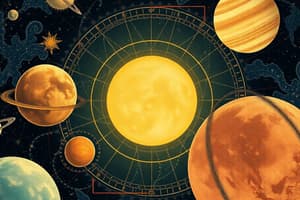Podcast
Questions and Answers
جوبيتر هو أكبر الكواكب في نظامنا الشمسي.
جوبيتر هو أكبر الكواكب في نظامنا الشمسي.
False (B)
ساتورن يتألف بشكل رئيسي من الماء والميثان.
ساتورن يتألف بشكل رئيسي من الماء والميثان.
False (B)
غزارة الأمطار على كوكب المريخ تفوق غزارة الأمطار على الأرض.
غزارة الأمطار على كوكب المريخ تفوق غزارة الأمطار على الأرض.
False (B)
كل من نبتون وأورانوس تتألفان بشكل رئيسي من الجليد.
كل من نبتون وأورانوس تتألفان بشكل رئيسي من الجليد.
أورانوس يُعرف بلونه الأزرق ومحوره المائل.
أورانوس يُعرف بلونه الأزرق ومحوره المائل.
مع حمولته الغازية، يُصنف المريخ على أنه عملاق غازي في النظام الشمسي.
مع حمولته الغازية، يُصنف المريخ على أنه عملاق غازي في النظام الشمسي.
الأرض تدور حول الشمس أكثر من عدد سنوات المريخ لإكمال دورته الشمسية.
الأرض تدور حول الشمس أكثر من عدد سنوات المريخ لإكمال دورته الشمسية.
الكواكب النجمية تحتوي على تيارات سحابية بارزة وأحزمة سحابية ظاهرة بوضوح.
الكواكب النجمية تحتوي على تيارات سحابية بارزة وأحزمة سحابية ظاهرة بوضوح.
الشمس تُعتبر نجمًا من نوع G-type main-sequence.
الشمس تُعتبر نجمًا من نوع G-type main-sequence.
أفضل زمان لتحرك الكواكب هو الأفليون، نقطة التقلب بعيدة الاقتراب من الشمس.
أفضل زمان لتحرك الكواكب هو الأفليون، نقطة التقلب بعيدة الاقتراب من الشمس.
Flashcards are hidden until you start studying
Study Notes
The Solar System: An Examination of Its Planets
The Solar System consists of the Sun and the celestial bodies that orbit it. These planets range from the smallest, Mercury, to the largest, Jupiter, and are categorized into terrestrial planets (Mercury, Venus, Earth, and Mars) and gas giants (Jupiter and Saturn). In addition to these, there are two ice giants (Uranus and Neptune) located further away from the Sun. The Solar System developed approximately 4.6 billion years ago, with its planets formed through a process known as accretion disc theory.
Terrestrial Planets
- Mercury: The smallest planet in our solar system, Mercury has a rocky surface and experiences extreme temperatures. Despite its proximity to the Sun, Mercury has a very thin atmosphere.
- Venus: A terrestrial planet with a thick atmosphere composed primarily of carbon dioxide, Venus is the second planet from the Sun. Its dense atmosphere creates a greenhouse effect, leading to extremely hot conditions on its surface.
- Earth: Our home planet, Earth is unique among the planets for its ability to support life. With a diverse range of ecosystems, Earth is the only planet known to host life.
- Mars: Often referred to as the Red Planet, Mars is characterized by its reddish appearance due to iron oxide (rust) found in its soil. Its atmosphere is much thinner than Earth's, and Mars' polar caps are made of water ice and carbon dioxide.
Gas Giants
- Jupiter: The largest planet in our solar system, Jupiter is predominantly composed of hydrogen and helium gas. It is famous for its Great Red Spot, a massive storm that has been raging for centuries.
- Saturn: Recognizable for its prominent ring system, Saturn is the second-largest planet in our solar system. Like Jupiter, Saturn is mostly made up of hydrogen and helium gas.
Ice Giants
- Uranus: Known for its blue color and tilted axis, Uranus is an ice giant composed primarily of water, methane, and ammonia ices. Its outermost layer is believed to be covered by a deep ocean of liquid water beneath a small rocky core.
- Neptune: Similar to Uranus, Neptune consists mainly of water, methane, and ammonia ices. It is the furthest known planet from the Sun in our solar system, and is surrounded by a strong magnetosphere.
Each planet in our solar system offers fascinating insights into the formation and evolution of our universe. From the rocky terrestrial planets to the gas and ice giants, their unique characteristics provide valuable information about the conditions that shaped our celestial neighborhood.
Studying That Suits You
Use AI to generate personalized quizzes and flashcards to suit your learning preferences.




